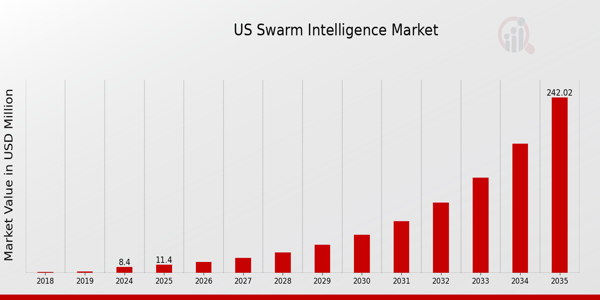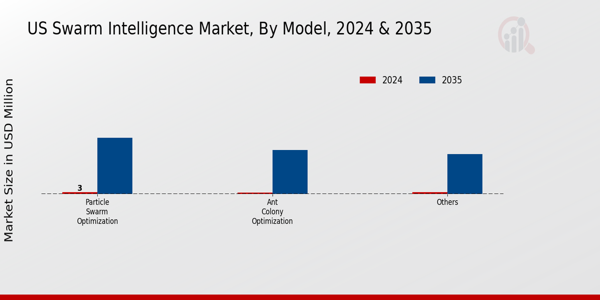US Swarm Intelligence Market Overview
As per MRFR analysis, the US Swarm Intelligence Market Size was estimated at 6 (USD Million) in 2023. The US Swarm Intelligence Market is expected to grow from 8.4 (USD Million) in 2024 to 242.02 (USD Million) by 2035. The US Swarm Intelligence Market CAGR (growth rate) is expected to be around 35.734% during the forecast period (2025 - 2035).
Key US Swarm Intelligence Market Trends Highlighted
The growing need for effective data management and decision-making procedures across several industries is propelling the US swarm intelligence market's notable expansion. Organizations are realizing how swarm intelligence can boost operational efficiency as a result of developments in artificial intelligence and machine learning.
Applications in urban planning, logistics, and military are especially noteworthy as government organizations look for creative answers to difficult problems. Swarm intelligence is being used by the military, in particular, to enhance tactical operations and situational awareness, demonstrating its vital significance in national security plans.
Incorporating swarm intelligence with the Internet of Things (IoT) to improve real-time data processing and analysis is just one of the many chances to seize in the US market. Swarm intelligence holds great promise for tackling urban issues including resource allocation, traffic control, and emergency response as cities transition to smart city projects.
Swarm intelligence systems are also being used more and more by sectors like transportation and agriculture to streamline workflow and manage resources, opening up new growth opportunities. Research and development efforts to increase the resilience of swarm-based applications have recently propelled the trend toward collaborative and autonomous systems in the US.
Both corporate businesses and academic organizations are investing in creating cutting-edge swarm intelligence frameworks and algorithms.
A thriving ecosystem for swarm intelligence solutions is being fostered by the growing cooperation between public and private partners in research programs. The US stands to gain from improved decision-making skills and operational efficacy across a variety of industries as these trends continue to develop.

Source: Primary Research, Secondary Research, MRFR Database and Analyst Review
US Swarm Intelligence Market Drivers
Increasing Demand for Autonomous Systems in Defense and Security
The United States has witnessed a significant surge in the adoption of autonomous systems within defense and security sectors, which is a critical driver for the US Swarm Intelligence Market.
In recent years, the U.S. Department of Defense has outlined plans for the development and procurement of unmanned aerial vehicles (UAVs) and swarming drones, aiming to enhance operational efficiency and minimize risks to personnel.
The U.S. military has invested approximately $7 billion in Research and Development (R&D) for autonomous technologies in 2020, with expectations to substantially increase this investment by implementing more sophisticated swarm intelligence systems.
According to the Defense Advanced Research Projects Agency (DARPA), the integration of swarm intelligence algorithms into aerial and naval platforms could potentially lead to a 20-30% increase in operational effectiveness, further solidifying the market's pivotal role in the defense and security frameworks of the U.S.
Growth in Simulation Technologies for Training
The growing focus on simulation technology in various sectors, including military, logistics, and emergency response, is significantly contributing to the US Swarm Intelligence Market. The U.S. military has recognized the need for advanced training platforms that utilize swarm intelligence to simulate real-life scenarios, leading to improved decision-making in high-stake environments.
Recent reports indicate that the U.S. Army will allocate around $1.4 billion for training technologies in 2023, partly driven by the need for realistic simulation support. This investment is poised to enhance the effectiveness of training programs, allowing operators to gain insights into swarm dynamics and collaborative behaviors in a controlled setting.
Rising Adoption of Swarm Technologies in Commercial Applications
The interest in applying swarm intelligence beyond military use is gaining momentum, particularly in commercial sectors such as agriculture, logistics, and environmental monitoring. Companies like Amazon and Google are exploring swarm-based delivery systems and fleet management solutions that optimize routes and reduce transportation costs.
In the agricultural domain, a recent report from the U.S. Department of Agriculture indicates that the integration of swarm robotics in crop monitoring can increase yield efficiency by 15-20%. This upward trend in commercial applications is not only expected to expand the US Swarm Intelligence Market but also drive innovation across various sectors reliant on autonomous systems.
US Swarm Intelligence Market Segment Insights
Swarm Intelligence Market Model Insights
The US Swarm Intelligence Market showcases a highly dynamic landscape that is underpinned by advanced models like Ant Colony Optimization and Particle Swarm Optimization among others. In recent years, the trend of integrating artificial intelligence with swarm intelligence has gained traction, particularly in optimizing complex logistical tasks and improving decision-making processes.
Ant Colony Optimization, inspired by the natural behavior of ants, plays a critical role in solving problems related to routing, scheduling, and network optimization. Its significance is highlighted by its ability to adapt and find optimal solutions through the simulation of ant behavior, making it a preferred choice in various industries such as telecommunications, transportation, and data analysis.
On the other hand, Particle Swarm Optimization is another essential model that draws inspiration from social behavior patterns observed in birds and fish. This model excels in scenarios requiring efficient exploration of large search spaces, making it widely applicable for optimizing functions in sectors including finance, engineering, and machine learning.
The adaptability and effectiveness of Particle Swarm Optimization for real-world applications contribute to its significant presence within the US Swarm Intelligence Market. Furthermore, the 'Others' category encompasses various emergent approaches and methodologies contributing to the overall evolution of swarm intelligence strategies.
With the underlying principles of collective behavior being applied across diverse fields like robotics, AI-based simulations, and environmental monitoring, this segment highlights the versatility and exhaustive potential of swarm intelligence technologies.
Combined, these models and approaches not only demonstrate a robust development trajectory in the US but also reveal growing opportunities for innovation and application in both established and emerging industries.
The acquisition of adequate funding and investment in Research and Development significantly aids in fostering advancements within these models, accelerating the growth of the overall US Swarm Intelligence Market and driving impactful results in operational efficiencies and effectiveness across multiple sectors.
As a result, the future of the market is poised for extensive exploration and integration of swarm intelligence solutions, further proving its pivotal role in shaping technological advancement and optimizing solutions in a myriad of real-world challenges.
The fusion of these various models and their applications ensures that the US remains a forerunner in swarm intelligence innovation, showcasing potential for expanded usability and efficiency across multiple domains, aligning with current market trends and consumer needs.

Source: Primary Research, Secondary Research, MRFR Database and Analyst Review
Swarm Intelligence Market Capability Insights
The Capability segment of the US Swarm Intelligence Market has been gaining notable attention due to its diverse applications across various industries. This segment can be dissected into several key areas, including Optimization, Routing, Scheduling, and Clustering, each playing a pivotal role in enhancing operational efficiencies.
Optimization is crucial for refining processes and resources, making it a valuable asset for organizations striving for cost-effectiveness. In contrast, Routing is significant for logistics and transportation sectors, ensuring seamless movement and distribution of goods.
Scheduling, on the other hand, is vital for industries that require precise timing and resource allocation, such as manufacturing and services. Clustering aids in data analysis and pattern recognition, providing insights that drive decision-making processes.
The synergy among these capabilities fosters innovation and drives demand, as businesses increasingly recognize the importance of employing swarm intelligence to solve complex problems.
As the market continues to evolve, these capabilities are expected to dominate by offering substantial benefits in automation, collaboration, and situational awareness, thereby enhancing the competitive edge of organizations operating in the US.
Swarm Intelligence Market Application Insights
The US Swarm Intelligence Market is undergoing significant expansion, particularly within the Application segment, which showcases its versatility across various innovative technologies. This segment encompasses vital areas such as Robotics, Drones, and Human Swarming, each contributing uniquely to market advancement.
Robotics has emerged as a key area, utilizing swarm intelligence to enhance automation, efficiency, and collaborative capacity in manufacturing and service sectors. Drones also play a crucial role, with applications in logistics, surveillance, and agricultural monitoring, thereby driving notable interest among industry players seeking cutting-edge solutions.
Human Swarming, as an area of focus, emphasizes the coordination and collaboration of groups of people to accomplish complex tasks effectively. The growth of this segment correlates with increasing governmental and military interest in developing coordinated strategies for operations, highlighting its significance in enhancing decision-making and efficiency.
As these applications evolve, they continue to attract investments and innovation, shaping the US Swarm Intelligence Market's landscape while highlighting opportunities for further growth and technological integration.
US Swarm Intelligence Market Key Players and Competitive Insights
The US Swarm Intelligence Market is characterized by a rapidly evolving landscape, driven by advancements in artificial intelligence and machine learning technologies. Various stakeholders, including technology firms, research institutions, and government agencies, play a pivotal role in the competitive dynamics of this market.
With the growing interest in swarm intelligence applications across sectors such as robotics, telecommunications, and defense, businesses are increasingly focusing on developing innovative solutions that leverage the collective behavior of decentralized systems.
This competitive environment fosters collaboration and ideation while also intensifying the race for technological supremacy. Companies that can effectively harness swarm intelligence principles stand to gain a considerable advantage in both market share and technological leadership.
Qualcomm has established a formidable presence in the US Swarm Intelligence Market, capitalizing on its strengths in semiconductor manufacturing and wireless technology. The company's proven track record in providing cutting-edge solutions for mobile devices and the Internet of Things (IoT) positions Qualcomm well in the context of swarm intelligence applications.
By integrating advanced algorithms and processing capabilities into its hardware, Qualcomm has made significant strides in enabling efficient communication between interconnected devices. This capability is particularly essential for swarm systems where coordination among multiple agents is crucial for optimal performance.
Through its innovative approach to chip design and emphasis on R&D, Qualcomm continues to enhance its offerings in the swarm intelligence domain, further solidifying its competitive position in the US market.
Intel similarly possesses a strong foothold within the US Swarm Intelligence Market, focusing on high-performance processors and comprehensive data solutions tailored specifically for swarm intelligence applications.
The company's portfolio includes advanced computing solutions that support machine learning and artificial intelligence, enabling faster and more accurate decision-making processes essential in swarm dynamics. Intel actively engages in strategic partnerships and acquisitions to bolster its capabilities in this field.
Key products and services, such as its Neuromorphic Computing initiative, demonstrate its commitment to driving innovation in swarm intelligence. Additionally, Intel's investments in research and development underscore its ambition to remain at the forefront of this rapidly changing market landscape.
Overall, the company's technological prowess, driven by a combination of cutting-edge products and strategic initiatives, positions Intel as a key player shaping the future of swarm intelligence in the US.
Key Companies in the US Swarm Intelligence Market Include
- Qualcomm
- Intel
- Honeywell
- Northrop Grumman
- Tesla
- Siemens
- Raytheon Technologies
- Amazon
- Google
- Cisco Systems
- Microsoft
- Boeing
- Oracle
- IBM
- Lockheed Martin
US Swarm Intelligence Market Developments
In order to improve coordination and efficiency across several fulfillment centers, Amazon stated in January 2025 that it will be expanding its autonomous warehouse robots on a broad scale utilizing cutting-edge swarm intelligence algorithms.
Tesla introduced a new fleet management system in November 2024 that optimizes autonomous electric vehicle routing in metropolitan settings by utilizing swarm intelligence concepts. In March 2025, the U.S. Department of Defense awarded Northrop Grumman a contract to build swarm-capable unmanned aerial vehicles (UAVs) for use in reconnaissance, surveillance, and intelligence operations.
Google increased the scope of its AI research projects in September 2024, concentrating on decentralized machine learning models to enhance swarm robotics capabilities for various applications. In October 2023, Honeywell unveiled an industrial automation platform that incorporates swarm intelligence to streamline logistics and production procedures.
In addition, Raytheon Technologies unveiled developments in swarm drone technology for cooperative defense operations in December 2023. These advancements demonstrate the US's strategic emphasis on incorporating swarm intelligence into industries including manufacturing, logistics, transportation, and defense, supported by investments from both government and private tech firms.
The US continues to dominate the world in swarm intelligence research and applications thanks to the continuous innovation.
Swarm Intelligence Market Segmentation Insights
-
Swarm Intelligence Market Model Outlook
- Ant Colony Optimization
- Particle Swarm Optimization
- Others
-
Swarm Intelligence Market Capability Outlook
- Optimization
- Routing
- Scheduling
- Clustering
-
Swarm Intelligence Market Application Outlook
- Robotics
- Drones
- Human Swarming
| Report Attribute/Metric |
Details |
| Market Size 2023 |
6.0(USD Million) |
| Market Size 2024 |
8.4(USD Million) |
| Market Size 2035 |
242.02(USD Million) |
| Compound Annual Growth Rate (CAGR) |
35.734% (2025 - 2035) |
| Report Coverage |
Revenue Forecast, Competitive Landscape, Growth Factors, and Trends |
| Base Year |
2024 |
| Market Forecast Period |
2025 - 2035 |
| Historical Data |
2019 - 2024 |
| Market Forecast Units |
USD Million |
| Key Companies Profiled |
Qualcomm, Intel, Honeywell, Northrop Grumman, Tesla, Siemens, Raytheon Technologies, Amazon, Google, Cisco Systems, Microsoft, Boeing, Oracle, IBM, Lockheed Martin |
| Segments Covered |
Model, Capability, Application |
| Key Market Opportunities |
Autonomous delivery systems, Disaster response automation, Smart agriculture solutions, Enhanced military operations, Real-time data analysis |
| Key Market Dynamics |
increasing demand for autonomous systems, advancements in AI algorithms, growing need for optimal resource allocation, rise in military applications, enhancing data analysis capabilities |
| Countries Covered |
US |
Frequently Asked Questions (FAQ):
The US Swarm Intelligence Market was valued at 8.4 million USD in 2024.
By 2035, the US Swarm Intelligence Market is anticipated to reach a value of 242.02 million USD.
The expected CAGR for the US Swarm Intelligence Market from 2025 to 2035 is 35.734%.
In 2024, Particle Swarm Optimization contributed 3.0 million USD to the US Swarm Intelligence Market.
The revenue for Ant Colony Optimization is projected to reach 75.8 million USD in 2035.
Major players include Qualcomm, Intel, Honeywell, Northrop Grumman, and Tesla among others.
By 2035, Particle Swarm Optimization is expected to account for 97.5 million USD of the US Swarm Intelligence Market.
The US Swarm Intelligence Market presents growth opportunities in various applications across industries such as robotics and data analysis.
The US market for Swarm Intelligence is one of the largest and most advanced globally.
Challenges include technological limitations and the need for further advancements in algorithms and applications.
















